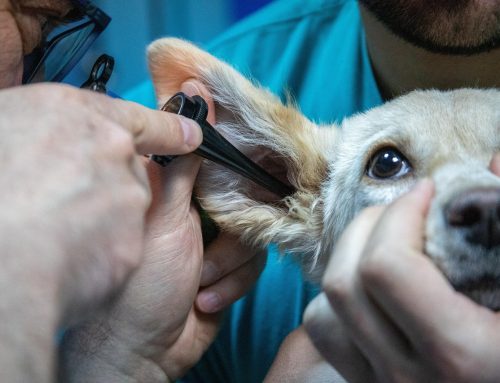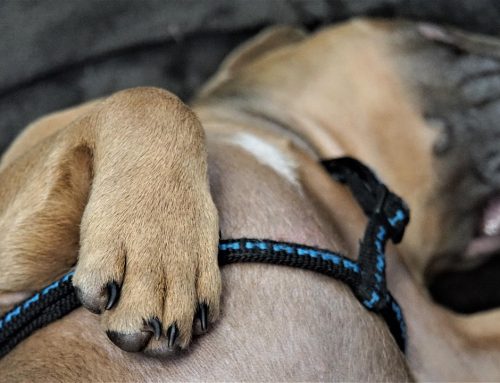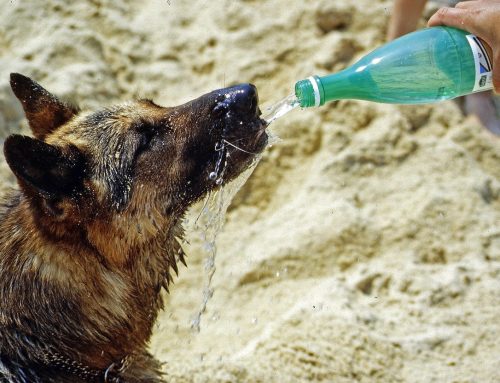
Ringworm in dogs often shows up as circular patches of hair loss. These areas usually have a red, scaly border with a clearer center, giving them a distinctive ring-like appearance. The skin in these spots may look dry, flaky, or crusted over, and there may be visible redness or inflammation around the edges. Sometimes, the affected skin is slightly raised or irritated.
Not all dogs with ringworm will itch, but some might scratch, lick, or chew at the irritated areas. The hair around the infection site can appear brittle, broken, or patchy, almost as if it’s been chewed off. Ringworm is most commonly found on the head, ears, paws, and forelegs, although it can spread to any part of the body if left untreated.
Despite its name, ringworm is not caused by a worm—it’s a fungal infection. It’s also highly contagious and can spread to other pets and even humans. If you notice any of these signs, it’s important to visit your vet for confirmation, usually through a fungal culture or a special light called a Wood’s lamp. Early diagnosis and treatment are key to preventing it from spreading further.
How Vets Diagnose Ringworm in Dogs
If your dog has strange-looking patches of hair loss or dry, scaly skin, you might wonder if it’s ringworm. Even though the name sounds like a parasite, ringworm is actually a fungal infection—and it can spread to other pets and even people. That’s why it’s important to get a proper diagnosis from your vet. Here’s how they figure it out:
Examining Your Dog’s Skin
The first thing your vet will do is take a close look at your dog’s skin and fur. Ringworm often causes round, bald spots with red or flaky skin. But those signs aren’t always unique to ringworm—other things like allergies, mange, or hot spots can look very similar. That’s why vets usually run a few tests to be sure.
Using a Special UV Light (Wood’s Lamp)
Some types of ringworm glow under a special purple light called a Wood’s lamp. Your vet will turn off the lights in the room and shine this lamp over your dog’s fur. If the fungus is there, the affected areas might glow a yellow-green color. This test is fast and easy, but it doesn’t catch all types of ringworm. So if nothing glows, it doesn’t always mean your dog is in the clear.
Fungal Culture (Lab Test)
To be 100% sure, your vet may take a few hairs or a bit of skin from the spot and send it to a lab. There, they’ll place the sample in a special container to see if the fungus grows. This is called a fungal culture, and it’s the most reliable way to diagnose ringworm. The downside? It can take 1 to 2 weeks to get results.
Looking Under a Microscope
Sometimes the vet might also look at a hair or skin sample under a microscope. They’ll check for tiny fungal spores that live on the hair shaft. This test can give quick answers, but it isn’t always accurate. It’s often used alongside other tests.
DNA Test (PCR Test)
Some animal clinics offer a DNA test called a PCR test. It looks for the fungus’s genetic material and can tell you quickly if ringworm is present. It’s very accurate and faster than a culture, but it may not be available everywhere.

Why It’s Important to Know for Sure
Ringworm can spread quickly—not just to other dogs, but to cats and even humans. That’s why getting a correct diagnosis is important. The sooner you know what you’re dealing with, the sooner you can start treatment and stop it from spreading.
If your dog shows any signs of skin problems, don’t wait. Call your vet and schedule a visit. A few simple tests can make a big difference in keeping your dog, your family, and your other pets safe.
How is ringworm in dogs treated?
Treating ringworm in dogs usually involves a combination of antifungal medications, topical treatments, and cleaning your home to prevent the fungus from spreading or coming back.
Most dogs with ringworm need oral (by mouth) antifungal medication. The most common ones are itraconazole, terbinafine, or griseofulvin. These help kill the fungus from the inside out. Treatment usually lasts several weeks—even if your dog looks better sooner—because the fungus can stick around under the skin.
Topical Treatments
Vets often recommend antifungal shampoos, creams, or ointments to apply directly to the affected areas. Medicated shampoos with ingredients like miconazole or chlorhexidine can help reduce spores on the skin and fur. These are usually used two to three times a week.
Clipping the Fur
In long-haired breeds, the vet may recommend trimming or shaving the affected areas to make it easier to treat and reduce shedding of fungal spores into the environment.
Cleaning the Environment
Because ringworm is highly contagious and the spores can live in the environment for months, thorough cleaning is essential. You should:
- Vacuum carpets and furniture frequently
- Wash your dog’s bedding, collars, and toys in hot water
- Disinfect surfaces with a vet-approved cleaner or diluted bleach (usually 1:10 ratio with water)
Quarantine (Optional but Helpful)
If you have multiple pets or children, it’s best to isolate the infected dog while they’re being treated to prevent the spread.
How Long Does Treatment Take?
Treatment can take 6 to 12 weeks, depending on the severity of the infection and how well your dog responds. Vets often retest the dog before stopping treatment to make sure the fungus is truly gone.
If you follow the treatment plan and clean your home properly, ringworm is very treatable and your dog will recover fully.
Can you get ringworm from your dog?
Yes, you can get ringworm from your dog. Ringworm is a zoonotic disease, which means it can spread from animals to humans.
The fungus spreads through direct contact with an infected dog or by touching contaminated objects like bedding, brushes, furniture, or even shed fur and skin flakes. The spores can survive in the environment for months, making it easy to catch if proper cleaning isn’t done.
In humans, ringworm usually appears as a red, itchy, circular rash with a clearer center—often on the arms, legs, or scalp. Children, older adults, and people with weakened immune systems are more likely to catch it.
To protect yourself:
- Wash your hands after handling your dog.
- Wear gloves when applying medicated shampoos or creams.
- Keep infected pets away from common areas until they’re cleared by a vet.
- Clean and disinfect your home regularly, especially where your dog sleeps or plays.
If you think you’ve gotten ringworm from your dog, see your doctor or a dermatologist. It’s treatable with over-the-counter or prescription antifungal creams or pills.
How do you keep ringworm from spreading?
Ringworm is a contagious skin infection caused by a fungus, and it can spread from dogs to other pets or even people. To keep it from spreading, it’s important to treat your dog quickly and follow your vet’s instructions. Most dogs need antifungal medication along with a medicated shampoo or cream. Even if the skin looks better after a couple of weeks, you should keep giving the medicine until the vet says it’s safe to stop.
While your dog is being treated, try to keep them away from other animals and limit contact with people, especially kids or anyone with a weak immune system. You should also avoid letting your dog share toys, beds, or grooming tools with other pets. If your dog has long hair, your vet may recommend trimming it to help the treatment work better and reduce the number of fungal spores that can spread.
Keeping your home clean is just as important as treating your dog. Ringworm spores can live on surfaces, pet hair, and bedding for a long time. Vacuum daily and throw away the vacuum bag or empty the canister outside. Wash anything your dog uses—like blankets, towels, or toys—in hot water. For hard surfaces like floors and crates, you can use a diluted bleach solution or a vet-approved disinfectant.
Always wash your hands after touching your dog or cleaning up after them. It’s also a good idea to wear gloves when applying medication or giving baths. If you follow all these steps and keep up with vet visits, you’ll have a much better chance of stopping the ringworm from spreading and helping your dog heal completely.
Ringworm in Dogs
Ringworm in dogs is a contagious fungal infection that appears as circular patches of hair loss, scaly or red skin, and sometimes itching. It can spread to humans and other pets through direct contact or contaminated objects. Vets diagnose it using exams, UV light, fungal cultures, or lab tests, and treat it with antifungal medications, medicated shampoos, and environmental cleaning. To prevent it from spreading, infected dogs should be isolated, their belongings washed, and living areas disinfected regularly. Good hygiene, proper treatment, and follow-up with a vet are key to fully clearing the infection and avoiding reinfection.






